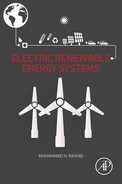Preface
The demand for energy, particularly in electrical forms, is ever increasing in order to improve the standard of living. Electric power generated from renewable energy sources is getting increasing attention and supports for new initiatives and developments in order to meet the increased energy demands around the world while minimizing the environmental effects. The renewable energy sources include solar, wind, hydroelectric, fuel cells, geothermal, biomass, and ocean thermal. The conversion of these energy sources into electric form requires the knowledge of three-phase supply, magnetic circuit, power transformers, and electric generators and control. Power electronic converters convert the electrical energy from the energy sources into different forms: AC–DC, DC–DC, and DC–AC to meet the utility demand.
Power electronics is an integral part of renewable energy for interfacing between the renewable sources and the utility supply and/or customers. Semiconductor devices are used as switches for power conversion or processing, as are solid-state electronics for efficient control of the amount of power and energy flow. The utility interface requites the knowledge of electric transmission, power systems, and the integration of power grid.
This book covers the energy sources, the energy conversion into electric form, the power conversion or processing to meet the utility demand, and transmission and interface to the power system and power grid. This book is designed to cover the state-of-the-art development in electric renewable energy covering from the source to the power grid.
The book is organized into four parts: (1) energy sources, (2) conversion to electric energy, (3) electric power conversion (or processing), and (4) interfacing to the electric power grid. It uses the tutorial approach so that engineering and nonengineering students or engineers can follow and then develop clear understanding leading to the in-depth analysis and design. It is intended as an undergraduate textbook for regular students and/or continuing education.
The list of contributors to this book spans the globe. The contributors are leading authorities in their areas of expertise. All were chosen because of their intimate knowledge of their subjects, and their contributions make this a comprehensive state-of-the-art guide to the expanding field of renewable energy. As expected, writing style of each contributor is different although the editorial staff attempted to make it more uniform.
Editor-in-Chief
